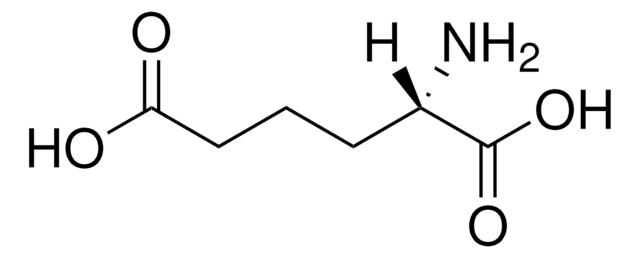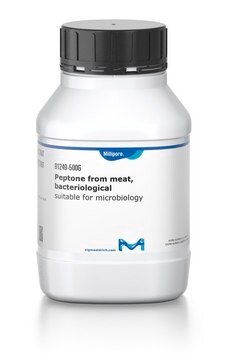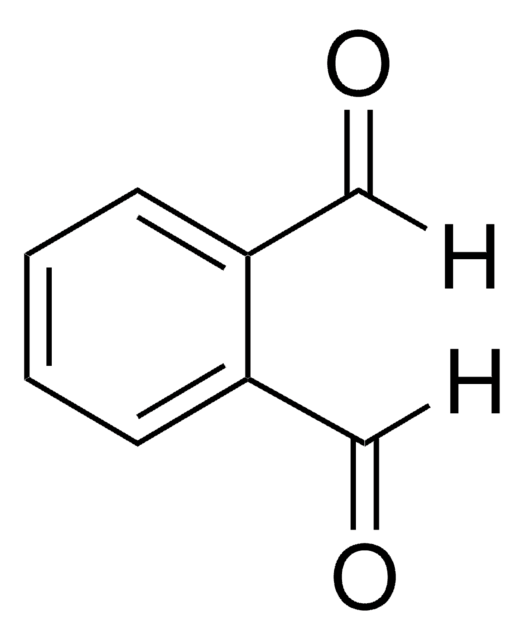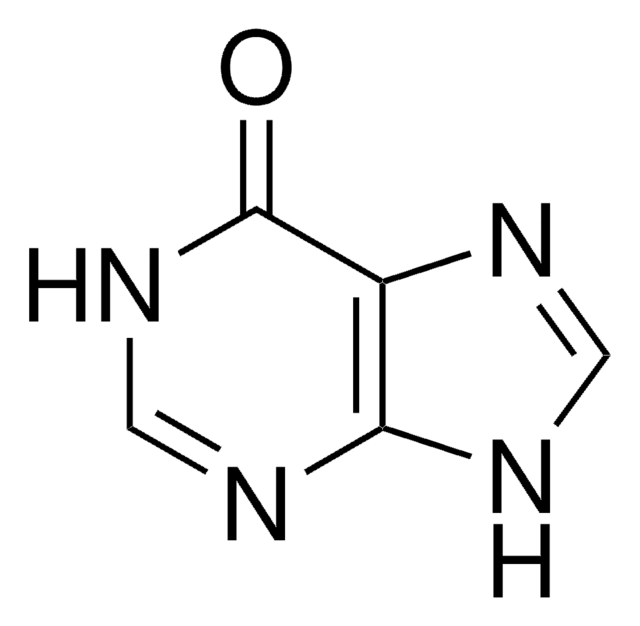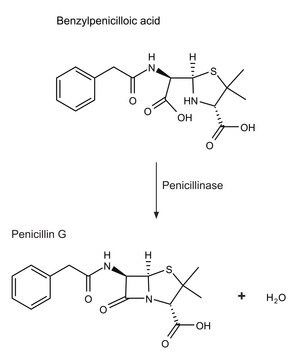A0637
DL-2-Aminoadipic acid
≥99% (TLC), powder, gliotoxic
Sinónimos:
DL-α-Aminoadipic acid
Iniciar sesiónpara Ver la Fijación de precios por contrato y de la organización
About This Item
Fórmula lineal:
HO2C(CH2)3CH(NH2)CO2H
Número de CAS:
Peso molecular:
161.16
Número CE:
Número MDL:
Código UNSPSC:
12352106
ID de la sustancia en PubChem:
NACRES:
NA.32
Productos recomendados
Nombre del producto
DL-2-Aminoadipic acid, ≥99%
Ensayo
≥99%
Formulario
powder
mp
196-198 °C (lit.)
temp. de almacenamiento
2-8°C
cadena SMILES
NC(CCCC(O)=O)C(O)=O
InChI
1S/C6H11NO4/c7-4(6(10)11)2-1-3-5(8)9/h4H,1-3,7H2,(H,8,9)(H,10,11)
Clave InChI
OYIFNHCXNCRBQI-UHFFFAOYSA-N
Información sobre el gen
rat ... Grin2b(24410)
¿Está buscando productos similares? Visita Guía de comparación de productos
Aplicación
DL-2-Aminoadipic acid (AAA) has been used as an astrotoxin to kill astrocytes that prevent efficient integration of transplanted cells into the retina. It has also been used as a gliotoxin to study the effect of astrocytic swelling on the tortuosity.
Acciones bioquímicas o fisiológicas
DL-2-Aminoadipic acid (AAA) is a six-carbon homolog of glutamate and a gliotoxic compound. It is generally used to considerably reduce the number of astroglia in cerebellar cultures that acts as a model to study the mechanisms of a-aminoadipic acid induced glial toxicity.
Palabra de señalización
Warning
Frases de peligro
Consejos de prudencia
Clasificaciones de peligro
Skin Sens. 1
Código de clase de almacenamiento
11 - Combustible Solids
Clase de riesgo para el agua (WGK)
WGK 3
Punto de inflamabilidad (°F)
Not applicable
Punto de inflamabilidad (°C)
Not applicable
Elija entre una de las versiones más recientes:
¿Ya tiene este producto?
Encuentre la documentación para los productos que ha comprado recientemente en la Biblioteca de documentos.
Los clientes también vieron
Bhagyalaxmi S Ganesh et al.
PloS one, 6(3), e18305-e18305 (2011-04-13)
Reactive gliosis is a hallmark of many retinal neurodegenerative conditions, including glaucoma. Although a majority of studies to date have concentrated on reactive gliosis in the optic nerve head, very few studies have been initiated to investigate the role of
Saadet Mercimek-Mahmutoglu et al.
Pediatrics, 129(5), e1368-e1372 (2012-04-25)
Pyridoxine-dependent epilepsy (PDE) was first described in 1954. The ALDH7A1 gene mutations resulting in α-aminoadipic semialdehyde dehydrogenase deficiency as a cause of PDE was identified only in 2005. Neonatal epileptic encephalopathy is the presenting feature in >50% of patients with
H Bräuner-Osborne et al.
Journal of medicinal chemistry, 39(16), 3188-3194 (1996-08-02)
The homologous series of acidic amino acids, ranging from aspartic acid (1) to 2-aminosuberic acid (5), and the corresponding series of 3-isoxazolol bioisosteres of these amino acids, ranging from (RS)-2-amino-2-(3-hydroxy-5-methylisoxazol-4-yl)acetic acid (AMAA, 6) to (RS)-2-amino-6-(3-hydroxy-5-methylisoxazol-4-yl)hexanoic acid (10), were tested as
Gliotoxin-induced swelling of astrocytes hinders diffusion in brain extracellular space via formation of dead-space microdomains
Sherpa AD, et al.
Glia, 62(7), 1053-1065 (2014)
The toxic effect of sodium glutamate and DL-$\alpha$-aminoadipic acid on rat retina: Changes in high affinity uptake of putative transmitters
Karlsen RL, et al.
Journal of Neurochemistry, 31(4), 1055-1061 (1978)
Nuestro equipo de científicos tiene experiencia en todas las áreas de investigación: Ciencias de la vida, Ciencia de los materiales, Síntesis química, Cromatografía, Analítica y muchas otras.
Póngase en contacto con el Servicio técnico